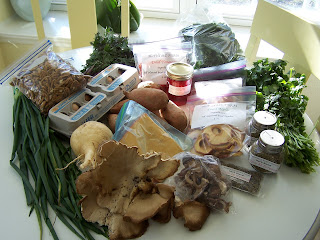Indeed, we have no bananas. Unfortunately for us, we also have no coffee, sugar, oranges, cinnamon, salt, bread, or cashews. The list goes on and on, but you get the idea. Truthfully, some of those things are still lurking in our pantry just feet from where I now sit writing this blog entry. However, beginning next week, we will not be able to enjoy them - at least not if we are going to meet the challenge of 100 mile dining. When journalists and partners Alisa Smith and J.B. MacKinnon pioneered the 100 mile diet experience, they allowed themselves the luxury of using any of the items still in their cupboards - a fact that my wife Joselle is quick to point out. But they were eating within 100 miles of their home in Vancouver, B.C. for an entire year; our challenge is only six weeks long. (Check out their book, Plenty: Eating Locally on the 100 Mile Diet, here.)
Our timing could be better. The dead of winter, even the mild winter climate change has blessed us with thus far, does not provide the variety our western palates crave. To further complicate matters, I have some childhood trauma connected with root vegetables, a winter staple. One word: rutabagas. As vegetarians, North Carolina’s wealth of poultry and hog farms, and its abundance of grass-fed beef, will not help us. And much of the produce that does grow here (like berries, peaches, watermelons, eggplants, green beans, and cucumbers) is not growing right now. However, in order to include this six week experiment as part of my larger study of pro-environmental behavioral change, mid-February is as late as I dare to begin, because - and believe me when I tell you this - I want to graduate on time!
Of course, before I committed to this project, I did my homework. After all I do not want for my wife, who is truly a good sport to support me in a variety of crazy whims, and me to starve. It’s true that we could live off of our fat for a while, but who wants to do that! In addition to a variety of farmers markets and the organic produce delivery service to which we already subscribe, I found plenty of dairy products and even a mill that works with regional growers of heirloom, organic grains. I believed this would be a snap! The single scariest aspect of the undertaking is that I will be doing all of the cooking for six weeks. It’s not that I am a bad cook - when I do cook, the food is well received - it’s just that I rarely cook. I am not efficient, skilled, or comfortable in the kitchen.
My plan started to unravel after a conversation with our organic produce delivery service. Unlike a CSA, our service is not all local. For example, they provide us with kiwis from New Zealand and citrus fruits from Florida. However, they also provide locally grown produce like sweet potatoes and kale. One reason we selected their service is that it is fully customizable, which means that for six weeks we can choose to opt out of long distance produce in favor of local options. But, as it turns out, the local produce our service provides comes primarily from the extreme eastern part of the state, which is outside of our 100 mile radius. See the map below.
Next we visited the Charlotte Regional Farmers Market, which is run by the State of North Carolina Department of Agriculture & Consumer Services. The Charlotte Market, which is the largest in our area, is open year-round at least five days per week. The challenge of the Charlotte Market is navigating through the prepared foods, produce distributors, and non-food booths (like soaps, plants and flowers) to find actual locally grown foods. We found herbs, mushrooms, pecans, kale, sweet potatoes, and, yes, even rutabaga, as well as dried apple rings, dried tomato slices, and eggs. Though this is a start, it is insufficient to feed us for six weeks.
The cheese we found came from "the North Carolina mountains," but the farmer who sold it to us did not make it and could not be more specific. We also indulged in a jar of currant jelly made by a sweet lady from neighboring Gastonia. Though the currants grow on her property, the jelly also contains sugar and pectin, which are not local. Therefore, neither the jelly nor the cheese will qualify for our dining experiment.
Since no one at the Charlotte Market was selling dairy (other than goat cheese), we visited Earth Fare, a regional grocer similar to Whole Foods, in search of Ashe County Cheese. Made in West Jefferson, NC since 1930, Ashe County Cheese is well within a 100 mile radius. Happily, we found two varieties, North Carolina Cheddar with Caraway and North Carolina Pepper Jack. Then I read the ingredients: pasteurized milk, cheese culture, salt, enzymes, and caraway or jalapeno peppers respectively. SALT! I have no idea if cheese culture, enzymes, caraway, or jalapeno peppers are local, but I know the salt is not. Freak. Perhaps I have made a horrible mistake...


You can do it!!
ReplyDeleteWhat an undertaking! You both can do it. I'm cheering for you!
ReplyDelete-jenny